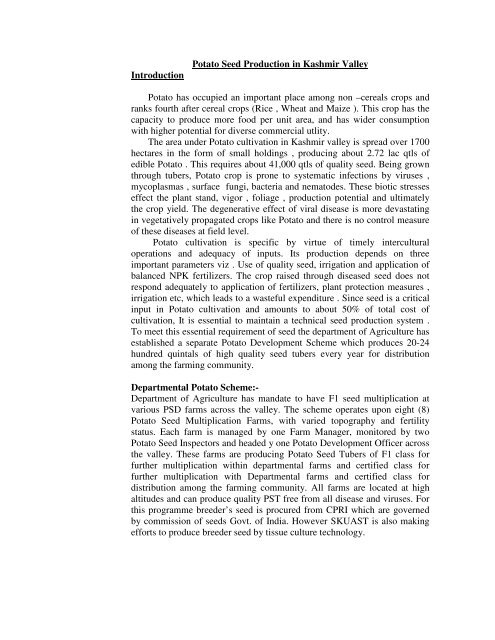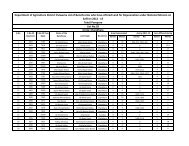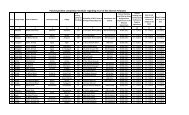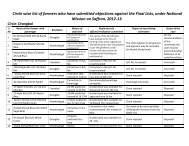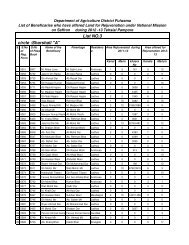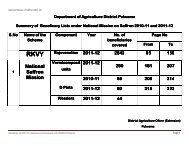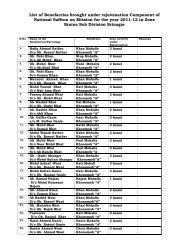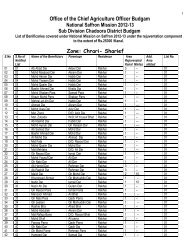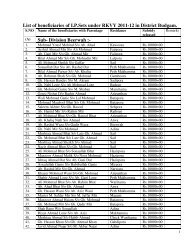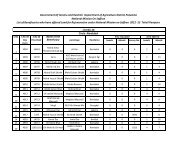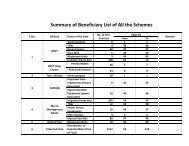Potato Seed Production in Kashmir Valley Introduction Potato has ...
Potato Seed Production in Kashmir Valley Introduction Potato has ...
Potato Seed Production in Kashmir Valley Introduction Potato has ...
Create successful ePaper yourself
Turn your PDF publications into a flip-book with our unique Google optimized e-Paper software.
<strong>Introduction</strong><br />
<strong>Potato</strong> <strong>Seed</strong> <strong>Production</strong> <strong>in</strong> <strong>Kashmir</strong> <strong>Valley</strong><br />
<strong>Potato</strong> <strong>has</strong> occupied an important place among non –cereals crops and<br />
ranks fourth after cereal crops (Rice , Wheat and Maize ). This crop <strong>has</strong> the<br />
capacity to produce more food per unit area, and <strong>has</strong> wider consumption<br />
with higher potential for diverse commercial utlity.<br />
The area under <strong>Potato</strong> cultivation <strong>in</strong> <strong>Kashmir</strong> valley is spread over 1700<br />
hectares <strong>in</strong> the form of small hold<strong>in</strong>gs , produc<strong>in</strong>g about 2.72 lac qtls of<br />
edible <strong>Potato</strong> . This requires about 41,000 qtls of quality seed. Be<strong>in</strong>g grown<br />
through tubers, <strong>Potato</strong> crop is prone to systematic <strong>in</strong>fections by viruses ,<br />
mycoplasmas , surface fungi, bacteria and nematodes. These biotic stresses<br />
effect the plant stand, vigor , foliage , production potential and ultimately<br />
the crop yield. The degenerative effect of viral disease is more devastat<strong>in</strong>g<br />
<strong>in</strong> vegetatively propagated crops like <strong>Potato</strong> and there is no control measure<br />
of these diseases at field level.<br />
<strong>Potato</strong> cultivation is specific by virtue of timely <strong>in</strong>tercultural<br />
operations and adequacy of <strong>in</strong>puts. Its production depends on three<br />
important parameters viz . Use of quality seed, irrigation and application of<br />
balanced NPK fertilizers. The crop raised through diseased seed does not<br />
respond adequately to application of fertilizers, plant protection measures ,<br />
irrigation etc, which leads to a wasteful expenditure . S<strong>in</strong>ce seed is a critical<br />
<strong>in</strong>put <strong>in</strong> <strong>Potato</strong> cultivation and amounts to about 50% of total cost of<br />
cultivation, It is essential to ma<strong>in</strong>ta<strong>in</strong> a technical seed production system .<br />
To meet this essential requirement of seed the department of Agriculture <strong>has</strong><br />
established a separate <strong>Potato</strong> Development Scheme which produces 20-24<br />
hundred qu<strong>in</strong>tals of high quality seed tubers every year for distribution<br />
among the farm<strong>in</strong>g community.<br />
Departmental <strong>Potato</strong> Scheme:-<br />
Department of Agriculture <strong>has</strong> mandate to have F1 seed multiplication at<br />
various PSD farms across the valley. The scheme operates upon eight (8)<br />
<strong>Potato</strong> <strong>Seed</strong> Multiplication Farms, with varied topography and fertility<br />
status. Each farm is managed by one Farm Manager, monitored by two<br />
<strong>Potato</strong> <strong>Seed</strong> Inspectors and headed y one <strong>Potato</strong> Development Officer across<br />
the valley. These farms are produc<strong>in</strong>g <strong>Potato</strong> <strong>Seed</strong> Tubers of F1 class for<br />
further multiplication with<strong>in</strong> departmental farms and certified class for<br />
further multiplication with Departmental farms and certified class for<br />
distribution among the farm<strong>in</strong>g community. All farms are located at high<br />
altitudes and can produce quality PST free from all disease and viruses. For<br />
this programme breeder’s seed is procured from CPRI which are governed<br />
by commission of seeds Govt. of India. However SKUAST is also mak<strong>in</strong>g<br />
efforts to produce breeder seed by tissue culture technology.
Statistical Position of Various Farms is tabulated under:-<br />
S.No. Name of Farm<br />
Total<br />
Geographical<br />
Area (ha)<br />
Cultivable Area<br />
(ha)<br />
Area under cultivation<br />
dur<strong>in</strong>g 2009 (ha)<br />
1 Bosa<strong>in</strong> 60 36 9.50<br />
2 Kalnag 73 18.50 13.90<br />
3 Sedow 3.5 3.00 1.00<br />
4 Yarikhah 75 18.45 2.10<br />
5 Dobighat, Gulmarg 20 12.50 0.35<br />
6 Ismarg 2.00 1.85 1.85<br />
7 Dawar 2.00 1.70 1.30<br />
8 Aru 30 3.00 -<br />
Total 265.50 95.00 30.00<br />
Targets achieved from last three years.<br />
S.No. Year Area brought under cultivation<br />
<strong>in</strong> (Hectares)<br />
<strong>Production</strong> <strong>in</strong><br />
Qtls<br />
1 2006-07 29.65 2552.50<br />
2 2007-08 26.55 1400.52<br />
3 2008-09 25.83 2394.85


